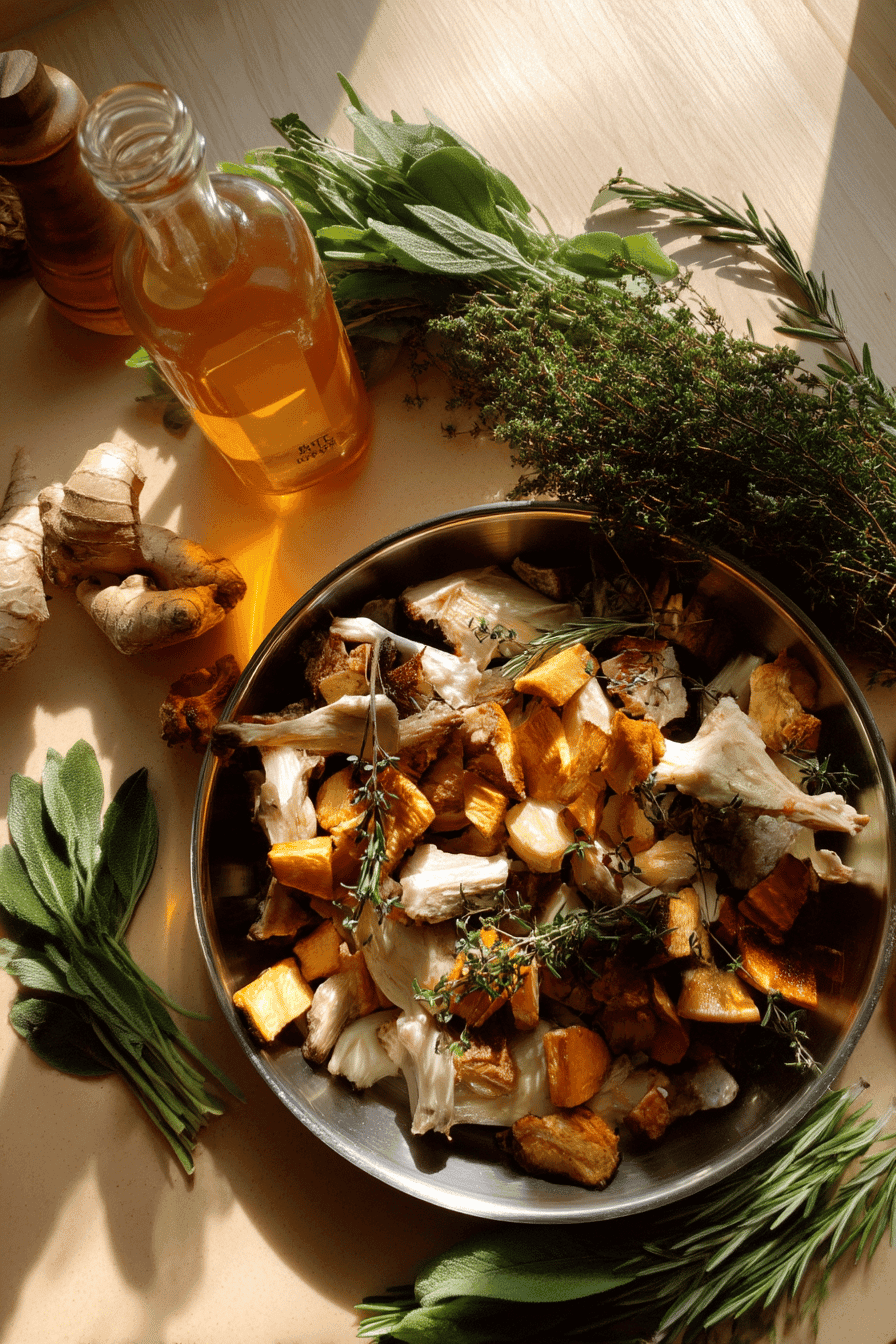Benefits and Advantages of turkey stock
Turkey stock is a nutritious and flavorful kitchen staple prized for its versatility and simplicity. It offers numerous benefits, including being an excellent way to use leftover turkey parts, reducing food waste and promoting sustainable cooking. Packed with minerals and natural gelatin from turkey bones, it supports joint health and digestion. The slow simmering process extracts rich, savory flavors that enhance soups, stews, gravies, and sauces without adding excess calories or fat. Turkey stock is naturally low-calorie, easily customizable to fit various dietary needs, and provides a comforting, wholesome base for many dishes. Its deep, robust character adds complexity and warmth to meals, making it a practical and nourishing foundation for home cooking.
Jump to:
- Benefits and Advantages of turkey stock
- Essential Ingredients for turkey stock
- Dietary Substitutions to Customize Your turkey stock
- How to Prepare the Perfect turkey stock: Step-by-Step Guide
- Mastering turkey stock: Advanced Tips and Variations
- How to Store turkey stock: Best Practices
- Nutritional Value of turkey stock
- FAQs: Frequently Asked Questions About turkey stock
- What ingredients do I need to make homemade turkey stock?
- How long should I simmer turkey stock for the best flavor?
- Can I freeze turkey stock, and how should I store it?
- Can I use turkey legs instead of wings to make stock?
- Should I roast or brown the vegetables when making turkey stock?
- Homemade Turkey Stock Recipe for Rich and Flavorful Thanksgiving Dishes
- Ingredients
- Instructions
- Last Step:
- Notes
- Nutrition
- Did you make this recipe?
Essential Ingredients for turkey stock
- 1 cooked turkey carcass (about 4 pounds), with most meat removed
- 2 large yellow onions, peeled and quartered (skins on for richer color if desired)
- 4 medium celery stalks, coarsely chopped (unpeeled)
- 4 large carrots, peeled and coarsely chopped
- 1 teaspoon whole black peppercorns (optional)
- A few sprigs of fresh parsley, thyme, and sage, or a combination (optional)
- About 1 gallon (approximately 16 cups or 3.8 liters) water to cover
- 1 tablespoon kosher salt (added at the end or adjusted to taste)
These core ingredients combine to create a deeply flavorful and nutrient-rich stock. Optional herbs and peppercorns enhance aroma and complexity, while keeping turkey stock gluten-free and adaptable for most dietary plans.

Dietary Substitutions to Customize Your turkey stock
Turkey stock can be tailored to accommodate a wide range of diets and preferences. For vegetarians or vegans, replace turkey bones with a mix of roasted mushrooms, seaweed (such as kombu) for umami, and extra vegetables like parsnips to maintain body and flavor. Gluten-free diets require monitoring seasoning additions to exclude any hidden gluten, ensuring stock purity. Lower sodium versions simply omit or reduce salt, focusing on fresh herbs for seasoning. For lighter stocks, use turkey breast bones or shorten simmering time to reduce fat and richness. Allergies to certain vegetables can be managed by swapping for tolerated alternatives, while maintaining aromatic basics like onion and celery. These substitutions keep turkey stock versatile and inclusive without sacrificing its comforting taste and nourishing potential.
How to Prepare the Perfect turkey stock: Step-by-Step Guide
- Gather ingredients: Collect turkey bones and carcass pieces along with onions, carrots, celery, herbs, peppercorns, and water. Select substitutions if following specific diets.
- Combine in stockpot: Place turkey carcass pieces in a large pot and cover entirely with about 1 gallon (16 cups) of cold water. Starting with cold water helps slow flavor extraction and gelatin release.
- Bring to boil and reduce heat: Heat over medium-high until boiling, then immediately lower to a gentle simmer. Skim off foam or impurities from the surface regularly for a clearer broth.
- Add vegetables and herbs: Add quartered onions, coarsely chopped celery and carrots, peppercorns, and fresh parsley, thyme, and sage sprigs as desired. Stir gently to combine evenly.
- Simmer slowly: Let the stock cook uncovered for 3 to 4 hours, occasionally skimming foam. Longer simmering results in richer flavor and more gelatin extraction.
- Strain stock: Pour the mixture through a fine mesh strainer or cheesecloth into a clean container to remove solids. For a clearer stock, strain a second time using a coffee filter or fine cloth.
- Cool and store: Allow the stock to cool completely, refrigerate, and then skim off any solidified fat from the surface. Store in airtight containers, refrigerated for up to a week or frozen in portions for up to three months.
This method ensures a rich, clear, and versatile turkey stock ideal for soups, gravies, and sauces. For further guidance, visit How to Make Turkey Stock.

Mastering turkey stock: Advanced Tips and Variations
To make a richer, more flavorful turkey stock, begin by roasting the turkey bones and vegetable scraps until golden brown. This caramelization adds depth and complexity to the broth. When simmering, add a splash of apple cider vinegar or lemon juice to help extract collagen from the bones, resulting in a gelatinous, body-rich stock. For clearer broth, strain the stock twice first through a fine mesh sieve, then a cheesecloth or coffee filter. Keep the cooking temperature low and steady to avoid cloudiness caused by boiling.
Herbs like rosemary, sage, and thyme can be introduced early in the process to infuse aromatic notes, while dried mushrooms add an umami boost for heartier flavors. Skimming fat periodically during cooking yields a cleaner stock; reserve the fat for making gravies or sautés. Experimenting with spices such as star anise or cinnamon subtly transforms the flavor profile without overpowering the natural turkey essence. These nuanced adjustments help personalize your stock, whether for soups, stews, or sauces, while maintaining the health benefits and traditional characteristics.
How to Store turkey stock: Best Practices
Proper storage is crucial to maintain the freshness and safety of your homemade turkey stock. After cooking, cool the stock rapidly by placing the pot in an ice bath or dividing it into smaller containers to speed cooling. Once cooled, transfer the stock into airtight containers for refrigeration, where it will keep well for up to 3 to 4 days.
For longer-term storage, freeze the stock in pint or quart-sized portions, leaving some headspace in containers to allow for expansion. Ice cube trays also work well for freezing small amounts perfect for recipe additions. Label each container with the date for easy rotation. When reheating, thaw in the refrigerator overnight or warm gently on the stove to preserve flavor and prevent bacterial growth. Avoid repeated freezing and thawing to maintain stock quality.
Nutritional Value of turkey stock
| Nutrient | Amount per Serving (approx.) |
|---|---|
| Calories | 4 kcal |
| Fat | 0.1 g |
| Saturated Fat | 0.0 g |
| Carbohydrates | 0.3 g |
| Fiber | 0.1 g |
| Sugars | 0.1 g |
| Protein | 0.4 g |
| Sodium | 3 mg |
Turkey stock is an excellent low-calorie and low-fat base rich in gelatin and collagen, known to support joint and skin health. It provides small amounts of protein and essential minerals such as calcium and magnesium. Its natural composition with no added sugars or carbohydrates makes it suitable for a variety of diets, including low-carb and ketogenic plans. Slow simmering preserves micronutrients, making turkey stock a wholesome addition to nourishing meals.

FAQs: Frequently Asked Questions About turkey stock
What ingredients do I need to make homemade turkey stock?
How long should I simmer turkey stock for the best flavor?
Can I freeze turkey stock, and how should I store it?
Can I use turkey legs instead of wings to make stock?
Should I roast or brown the vegetables when making turkey stock?

Homemade Turkey Stock Recipe for Rich and Flavorful Thanksgiving Dishes
🦃 Enhance your Thanksgiving dishes with this hearty homemade turkey stock, perfect for soups, stews, and gravies.
🥣 Utilize every part of your turkey for a rich flavor and ensure nothing goes to waste.
- Total Time: 3 to 4 hours 10 minutes
- Yield: About 2 quarts (8 cups) 1x
Ingredients
1 cooked turkey carcass (about 4 pounds), with most meat removed
2 large yellow onions, peeled and quartered
4 medium celery stalks, coarsely chopped
4 large carrots, peeled and coarsely chopped
1 teaspoon whole black peppercorns (optional)
A few sprigs of fresh parsley, thyme, sage (optional)
About 1 gallon (16 cups or 3.8 liters) water
1 tablespoon kosher salt
Instructions
1. Break the turkey carcass into large pieces and place in a stockpot with onions, celery, carrots, peppercorns, and herbs. Cover with water.
2. Bring to a boil over medium-high heat, then reduce to maintain a gentle simmer.
3. Simmer for 3 to 4 hours, stirring occasionally and adding water as necessary to keep bones submerged.
4. Strain the stock through a fine mesh strainer into a large bowl.
5. Let cool completely, refrigerate, and skim off fat when chilled.
Last Step:
Please leave a rating and comment letting us know how you liked this recipe! This helps our business to thrive and continue providing free, high-quality recipes for you.Notes
🌿 Save turkey necks and scraps to enhance flavor.
🧄 Keep onion skins for a rich color; caramelize vegetables for depth.
🧊 Use a fat separator for ease, and freeze extra stock for future use.
- Prep Time: 10 minutes
- Simmering: 3 to 4 hours
- Cook Time: 3 to 4 hours
- Category: Broth
- Method: Simmering
- Cuisine: American
- Diet: Gluten-Free
Nutrition
- Serving Size: 1 cup
- Calories: 4
- Sugar: 0.1 g
- Sodium: 3.0 mg
- Fat: 0.1 g
- Saturated Fat: 0.0 g
- Unsaturated Fat: N/A
- Trans Fat: 0 g
- Carbohydrates: 0.3 g
- Fiber: 0.1 g
- Protein: 0.4 g
- Cholesterol: 0 mg







